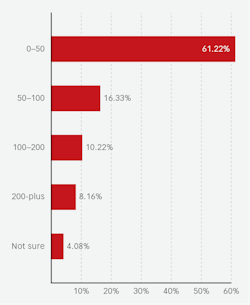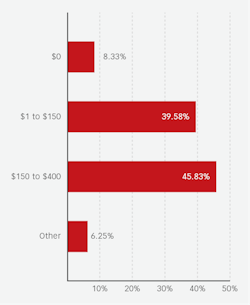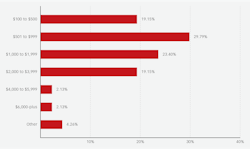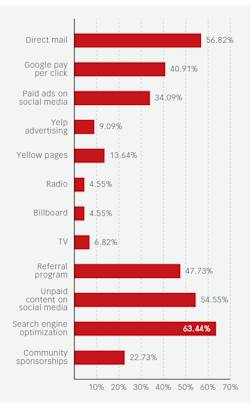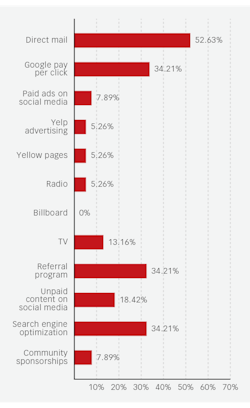Survey says: Most dentists (51%) report good marketing results from this tactic...
At the end of every year, I survey my database of dental clients. There are currently 6,222 of them, though not all of them have a campaign in progress. The survey questions center on the topic of marketing, but the survey touches on everything from in-office perks to how much new patients are spending on their first visit. I always look forward to this survey because it affords a snapshot of the industry and how things are changing. This year, there were some interesting answers among the 20 questions we asked. Here are a few that really caught my attention.
Survey highlights
Survey says: 72% of respondents have more than 16 new-patient inquiries per month.
A decent slice of dentists surveyed (22%) have 100-plus new-patient inquiries, but a bigger piece (28%) are receiving 15 or fewer. The complete range is shown in Figure 1.Survey says: 46% of dentists say new patients spend $150 to $400 on the first visit.
Interestingly, $150 seems to be the middle ground on the initial value of a new patient: 48% of dentists collect less than $150 and 46% collect more than $150 from new patients on the first visit, as shown in Figure 2.Survey says: 81% of respondents are collecting $500-plus from a new patient during the first year.
When taken with the previous survey question, we can conclude that many dentists are offering a lead-loss discount for initial exams. A lead-loss discount means you may not make a full profit on the first visit, but this “loss” is part of persuading patients to choose you in a competitive market—and recouped on future visits. As shown in Figure 3, dental practices are seeing a healthy payout from new patients as time goes on.
In a different question, 51% of dentists reported that a discounted initial exam worked well for attracting new patients, further supporting the lead-loss theory.Survey says: 94% of dentists retain new patients for more than one year.
The largest group of respondents (43%) said they retain a new patient for six to 10 years on average. This is an important factor when deciding what you’re willing to spend to acquire each new patient. The longer a patient stays with your practice equates to more appointments, more referrals, more production, and more revenue. This is called lifetime value.
Survey says: SEO and unpaid social media posts are among the most popular marketing strategies, but with limited success.
Among dentists surveyed, 55% and 64% reported regularly utilizing unpaid social media and SEO, respectively, in their ongoing marketing strategy (figure 4). Yet far fewer achieved good results from these methods, with reported success rates of 18% for unpaid social media and 34% for SEO (figure 5). On the flip side, 57% of dentists said they regularly utilize direct mail and 53% reported good results from it, the highest number among all marketing strategies.SEO still did rank among the highest strategies with “good” results, achieving similar marks as Google pay-per-click advertising and internal referral programs.
Survey says: Despite poor results, 50% will increase spending on SEO.
When dentists were asked which strategies they were planning to spend more money on in the coming year, SEO led the pack (figure 6). Referral programs came in second: 42% of dentists said they were planning to invest more in this area. Interestingly, these strategies only garnered “good” results among roughly 30% of the dentists we surveyed.Direct mail—which 53% of dentists reported getting “good” results from—lagged behind the pack, with only 30% of dentists planning to increase their mailing budgets. Might this be a result of some strategies being more in vogue than others?
Survey says: Almost 60% of dentists have 50 or fewer Google reviews.
Google reviews are the gold standard for social proof and where your reputation management efforts should be focused. To add to that, review signals (such as quantity, recency, etc.) factor into your Google search engine rankings, giving them SEO value as well.
Only about a third of dentists surveyed have more than 50 reviews, and another third lag even further behind with 11 to 25 reviews. If you don’t have a proactive plan in place to accelerate your Google review count, I suggest implementing one sooner rather than later.Author’s note: To view the entire survey and all of the answers in depth, visit postcardmania.com/survey.
About the Author

Joy Gendusa
Founder and CEO, PostcardMania
Joy Gendusa is the founder and CEO of PostcardMania. Using just postcards, a phone, and a computer, Gendusa built PostcardMania from a one-person start-up into an industry leader. PostcardMania serves 102,962 clients, including 6,980 dentists. Need help promoting your practice? Call one of PostcardMania’s dental marketing consultants at (844) 269-1836, or email Gendusa at [email protected].

